

Moremi. From Wikipedia, the free encyclopedia Moremi may refer to:

Obatala. Statue of Obàtálá in Costa do Sauípe, Bahía.
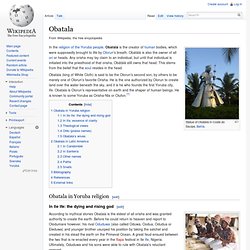
Obatala (king of White Cloth) is said to be the Olorun's second son, by others to be merely one of Olorun's favorite Orisha. He is the one authorized by Olorun to create land over the water beneath the sky, and it is he who founds the first Yoruba city, Ife. Obatala is Olorun's representative on earth and the shaper of human beings. He is known to some Yoruba as Orisha-Nla or Olufon.[1] Jarilo. The Slavic root jar or yar means spring or summer.
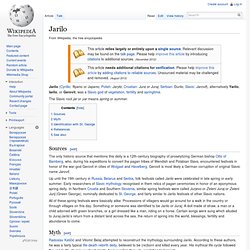
Sources[edit] The only historic source that mentions this deity is a 12th-century biography of proselytizing German bishop Otto of Bamberg, who, during his expeditions to convert the pagan tribes of Wendish and Polabian Slavs, encountered festivals in honor of the war-god Gerovit in cities of Wolgast and Havelberg. Gerovit is most likely a German corruption of original Slavic name Jarovit. Veles (god) Veles is one of few Slavic gods for which evidence of offerings can be found in all Slavic nations.
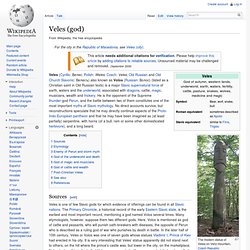
The Primary Chronicle, a historical record of the early Eastern Slavic state, is the earliest and most important record, mentioning a god named Volos several times. Many etymologists, however, suppose them two different gods. Here, Volos is mentioned as god of cattle and peasants, who will punish oath-breakers with diseases, the opposite of Perun who is described as a ruling god of war who punishes by death in battle.
Proserpina. Cult and myths[edit] Cult[edit] Myths[edit] In another version of the story, Proserpina ate only four pomegranate seeds, and she did so of her own accord.
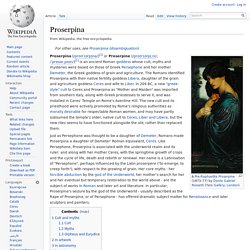
When Jupiter ordered her return, Pluto struck a deal with Jupiter, saying that since she had stolen his pomegranate seeds, she must stay with him four months of the year in return. Aeneas. In Greco-Roman mythology, Aeneas (/ɪˈniːəs/; Greek: Αἰνείας, Aineías, possibly derived from Greek αἰνή meaning "praise") was a Trojan hero, the son of the prince Anchises and the goddess Aphrodite (Venus).
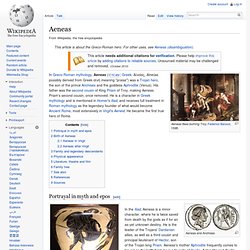
His father was the second cousin of King Priam of Troy, making Aeneas Priam's second cousin, once removed. Attis. Attis (Ancient Greek: Ἄττις or Ἄττης) was the consort of Cybele in Phrygian and Greek mythology.[2] His priests were eunuchs, the Galli, as explained by origin myths pertaining to Attis and castration.
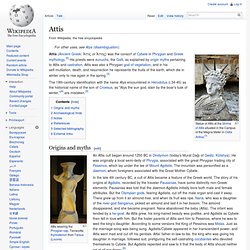
Attis was also a Phrygian god of vegetation, and in his self-mutilation, death, and resurrection he represents the fruits of the earth, which die in winter only to rise again in the spring.[3] The 19th-century identification with the name Atys encountered in Herodotus (i.34-45) as the historical name of the son of Croesus, as "Atys the sun god, slain by the boar's tusk of winter,"[4] are mistaken.[5] Baldr. "Each arrow overshot his head" (1902) by Elmer Boyd Smith.
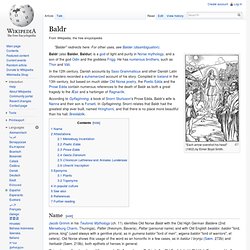
Baldr (also Balder, Baldur) is a god of light and purity in Norse mythology, and a son of the god Odin and the goddess Frigg. He has numerous brothers, such as Thor and Váli. Gullveig. In Norse mythology, Gullveig is a being who was speared by the Æsir, burnt three times, and yet thrice reborn.
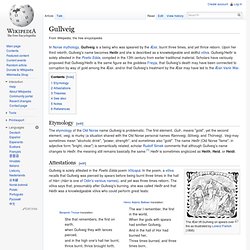
Upon her third rebirth, Gullveig's name becomes Heiðr and she is described as a knowledgeable and skillful völva. Gullveig/Heiðr is solely attested in the Poetic Edda, compiled in the 13th century from earlier traditional material. Scholars have variously proposed that Gullveig/Heiðr is the same figure as the goddess Freyja, that Gullveig's death may have been connected to corruption by way of gold among the Æsir, and/or that Gullveig's treatment by the Æsir may have led to the Æsir-Vanir War. Etymology[edit] Ohlone mythology. The Chochenyo (Chocheño) mythology of the San Francisco Bay Area has a strong culture hero figure named Kaknu, coyote's grandson, who is an anthropomorphic and closely resembles a peregrine falcon.
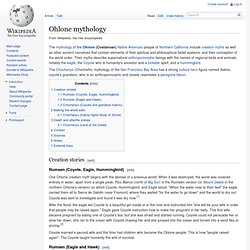
Creation stories[edit] Heitsi-eibib. Izanagi. Izanagi (イザナギ? , recorded in the Kojiki as 伊邪那岐 and in the Nihon Shoki as 伊弉諾) is a deity born of the seven divine generations in Japanese mythology and Shinto, and is also referred to in the roughly translated Kojiki as "male-who-invites" or Izanagi-no-mikoto ("Lord Izanagi").
It is also pronounced Izanagi-no-Okami ("The Great God Izanagi"). Accounts in mythology[edit] Izanagi and Izanami[edit] He with his spouse and younger sister Izanami gave birth to the many islands of Japan (kuniumi), and begat numerous deities of Shintoism (kamiumi). Chhinnamasta. Chhinnamasta (Sanskrit: छिन्नमस्ता, Bengali: ছিন্নমস্তা(অর্থাৎ যার মস্তক ছিন্ন), Chinnamastā, "She whose head is severed"), often spelled Chinnamasta and also called Chhinnamastika and Prachanda Chandika, is one of the Mahavidyas, ten Tantric goddesses and a ferocious aspect of Devi, the Hindu Divine Mother. Chhinnamasta can be easily identified by her fearsome iconography. The self-decapitated goddess holds her own severed head in one hand, a scimitar in another.
Three jets of blood spurt out of her bleeding neck and are drunk by her severed head and two attendants. Chhinnamasta is usually depicted standing on a copulating couple. Shiva. Shiva (Śiva; /ˈʃɪvə/ listen meaning "The Auspicious One"), also known as Mahadeva ("Great God"), is a popular Hindu deity and is considered to be the Supreme God within Shaivism, one of the three most influential denominations in Hinduism.[1][2] Shiva is regarded as one of the primary forms of God, such as one of the five primary forms of God in the Smarta tradition,[1] and "the Destroyer" or "the Transformer"[3] among the Trimurti, the Hindu Trinity of the primary aspects of the divine.
Shiva is also regarded as the patron god of yoga and arts.[4][5][6] Shiva, as we know him today, shares features with the Vedic god Rudra. Historians have also suggested that worship of Shiva existed in pre-Vedic times, but not all historians agree on this. Etymology and other names[edit] Kali. Etymology[edit] Kālī is the feminine form of kālam ("black, dark coloured").[3] Kāla primarily means "time" but also means "black" in honor of being the first creation before light itself. Kālī means "the black one" and refers to her being the entity of "time" or "beyond time. " Kāli is strongly associated with Shiva, and Shaivas derive the masculine Kāla (an epithet of Shiva) to come from her feminine name.
A nineteenth-century Sanskrit dictionary, the Shabdakalpadrum, states: कालः शिवः । तस्य पत्नीति - काली । Other names include Kālarātri ("black night"), as described above, and Kālikā ("relating to time"). Cronus. Ruler of the Titans in Ancient Greek mythology Mythology[edit] Only Cronus was willing to do the deed, so Gaia gave him the sickle and placed him in ambush.[4] When Uranus met with Gaia, Cronus attacked him with the sickle, castrating him and casting his testicles into the sea. From the blood that spilled out from Uranus and fell upon the earth, the Gigantes, Erinyes, and Meliae were produced.
The testicles produced a white foam from which the goddess Aphrodite emerged. For this, Uranus threatened vengeance and called his sons Titenes[a] for overstepping their boundaries and daring to commit such an act. Adonis. Adonis has had multiple roles, and there has been much scholarship over the centuries concerning his meaning and purpose in Greek religious beliefs. He is an annually-renewed, ever-youthful vegetation god, a life-death-rebirth deity whose nature is tied to the calendar. Min (god) Min is an Ancient Egyptian god whose cult originated in predynastic times (4th millennium BCE).[1] He was represented in many different forms, but was often represented in male human form, shown with an erect penis which he holds in his left hand and an upheld right arm holding a flail. Amun. "Amen Ra" redirects here.
Baʿal. Bronze figurine of a Baal, ca. 14th–12th century BC, found at Ras Shamra (ancient Ugarit) near the Phoenician coast. Musée du Louvre. Xipe Totec. Xipe Totec as depicted in the Codex Borgia, notice the bloody weapon and the flayed human skin he wears as a suit with the hands hanging down. Xipe Totec connected agricultural renewal with warfare.[8] He flayed himself to give food to humanity, symbolic of the way maize seeds lose their outer layer before germination and of snakes shedding their skin.
Without his skin, he was depicted as a golden god. Quetzalcoatl. Quetzalcoatl /ˌkɛtsɑːlˈkoʊɑːtəl/ (Classical Nahuatl: Quetzalcohuātl [ketsaɬˈko.aːtɬ]) is a Mesoamerican deity whose name comes from the Nahuatl language and means "feathered serpent".[1] The worship of a feathered serpent deity is first documented in Teotihuacan in the first century BCE or first century CE.[2] That period lies within the Late Preclassic to Early Classic period (400 BCE – 600 CE) of Mesoamerican chronology, and veneration of the figure appears to have spread throughout Mesoamerica by the Late Classic (600–900 AD).[3]
Phoenix (mythology) A phoenix depicted in a book of mythological creatures by FJ Bertuch (1747–1822). In Greek mythology, a phoenix or phenix (Greek: φοῖνιξ phoinix) is a long-lived bird that is cyclically regenerated or reborn. Wawalag. Julunggul. Eleusinian Mysteries. Persephone. Persephone as a vegetation goddess and her mother Demeter were the central figures of the Eleusinian mysteries that predated the Olympian pantheon and promised the initiated a more enjoyable prospect after death. Ishtar. Inanna. Odin. Dionysus. Zalmoxis. Jesus. Jesus Christ in comparative mythology. Descent to the underworld. Ra. Krishna. Orpheus.
Asclepius. Eshmun. Melqart. Baʿal. Jesus. Tammuz (deity) Dying god. Osiris. Adonis. Dionysus.